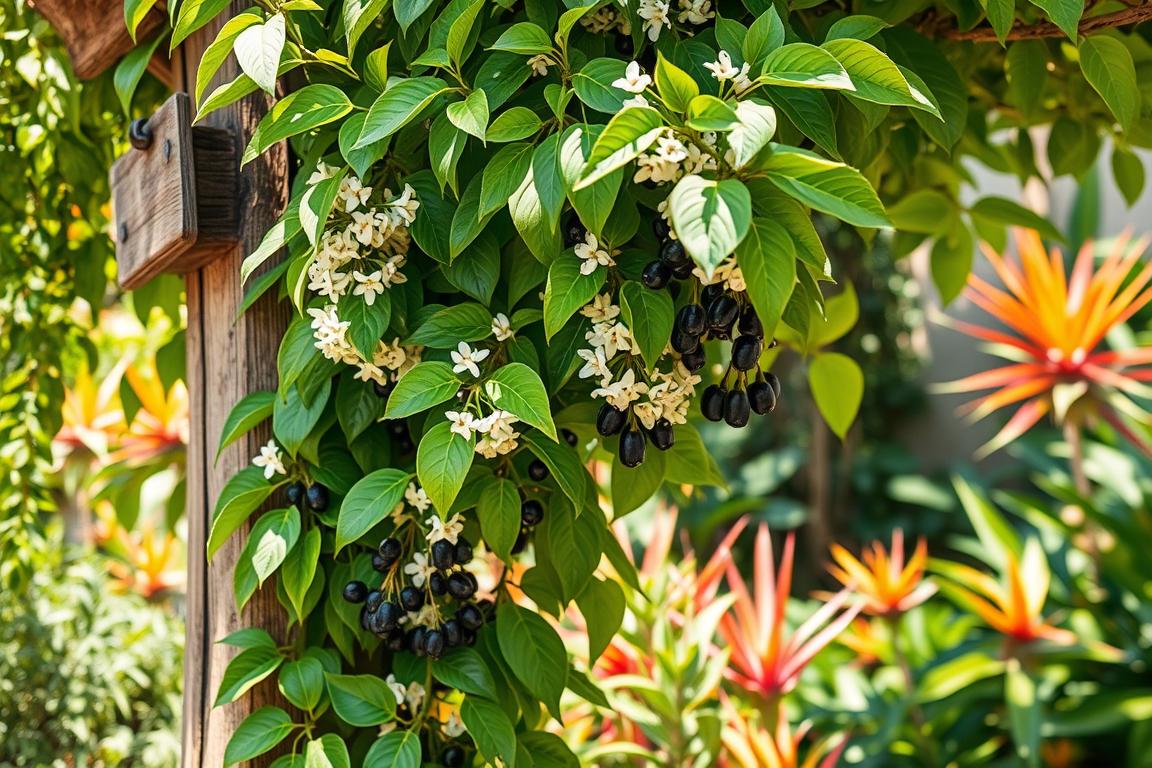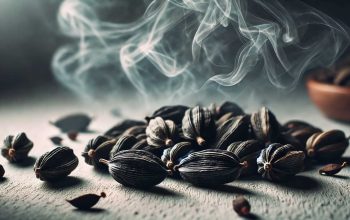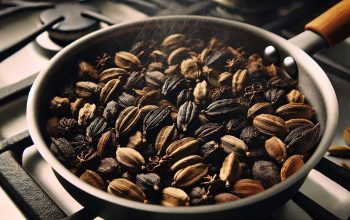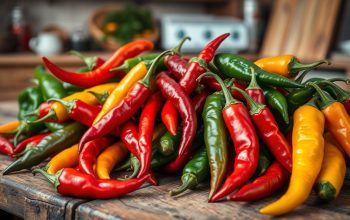I’m excited to share the story of black pepper, known as the “king of spices.” This spice has a long history, loved by ancient people. It has changed the way we trade and cook food.
Black pepper comes from Kerala, India. The piper nigrum vine grows peppercorns that people have loved for ages. Its strong smell and taste make it key in many dishes around the world.
Black pepper is more than just a spice. It was once very valuable, even used as money. People went far to get it, changing history.
Let’s explore black pepper’s world together. We’ll learn about its beginnings, what makes it special, and how it has shaped our world. Come see the magic of this “king of spices.”
The Ancient Legacy of Black Pepper
Black pepper’s story starts with ancient people. They called it “black gold.” It’s a spice with a long, exciting history.
Historical Trade Routes and Commerce
Black pepper’s journey shows its importance. Archaeologists found peppercorns from 2000 BCE in India. For over 4,000 years, people there grew it.
In the 10th century, Arabs controlled the pepper trade. They linked the Malabar Coast of India to the Mediterranean.
Black Pepper in Ancient Civilizations
The Greeks and Romans loved black pepper. They got it from India. Pliny the Elder wrote about pepper prices in Rome in 77 CE.
In the 5th century, Alaric, the king of the Visigoths, asked for 3,000 pounds of pepper. This was part of a ransom from Rome.
The Spice That Changed World History
Pepper’s charm led to world exploration. Europeans wanted to trade directly with India. The Portuguese, Dutch, and English took over the Indian Ocean trade.
Even with more pepper, it was still very valuable. It changed the world’s history and food.
| Fact | Statistic |
|---|---|
| Vietnam’s share of global black pepper production | 35% |
| Earliest physical remains of peppercorns found | 2000 BCE in India |
| Major black pepper-producing countries | India, Brazil, China, Sri Lanka |
| Peppercorns found in Ramses the Great’s tomb | 1213 BCE |
| Pepper demanded as ransom from Rome | 3,000 pounds by the Visigoths in 410 CE |
“Pepper was a widespread, if expensive, seasoning in the Roman Empire.”
Understanding Black Pepper: Origins and Characteristics
Black pepper comes from the Piper nigrum L. plant. This plant grows in India’s Western Ghat Mountains. It makes small berries called peppercorns.
These berries are dried to make different types of peppercorns. You can find them in green, black, and white colors. Black pepper tastes woody, piney, and warm.
| Peppercorn Variety | Flavor Profile | Processing |
|---|---|---|
| Black Pepper | Woody, piney, warm, earthy, pungent | Unripe berries dried in the sun |
| White Pepper | Milder, more subtle, less complex | Ripe berries soaked in water to remove the outer skin |
| Green Pepper | Fresh, bright, slightly grassy | Unripe berries preserved in brine or freeze-dried |
The Tellicherry pepper is the best quality black pepper. It’s from the Malabar Coast in India. It has a strong aroma and taste.
Black pepper is the most traded spice in the world. It’s used in many dishes. Chefs and home cooks love it for its unique taste.
The Botanical Profile of Piper Nigrum
Black pepper, also known as Piper nigrum, grows in the Malabar Coast of India. It can grow up to 10 meters tall. Its aerial roots make it a beautiful sight in gardens or plantations.
Plant Structure and Growth Requirements
Black pepper fruits are called peppercorns and are about 5 mm big. Ground black pepper has up to 3 percent essential oil. This gives it a unique taste.
Pepper plants start to bear fruits in 2 to 5 years. They can keep producing for up to 40 years. This makes them a great crop for the long term.
Cultivation Conditions and Climate Needs
Piper nigrum loves hot weather and lots of rain. It grows best in partial shade. It needs a temperature between 55-90°F and rich soil.
It grows well in tropical and subtropical places. This includes Southern India and Sri Lanka. It’s a versatile plant that thrives in many climates.
Life Cycle of the Pepper Vine
- Height: 10.00 to 15.00 feet
- Spread: 10.00 to 15.00 feet
- Native Range: Southern India and Sri Lanka
- Bloom Time: Seasonal
- Bloom Color: Yellowish-green
The pepper plant’s life cycle is amazing. It starts producing fruit in 2-5 years. It can live for up to 40 years. This makes it a favorite among growers and food lovers.
“Black pepper (Piper nigrum) is one of the most popular spices worldwide, with production occurring in countries like India, Malaysia, Indonesia, China, Thailand, Sri Lanka, Vietnam, Brazil, and Madagascar.”
Different Types of Peppercorns Explained
Peppercorns are the berries from the Piper Nigrum vine. They come in many colors and tastes. Knowing the differences between green, black, and white peppercorns is important.
Green peppercorns are picked early and can be used fresh or dried. They taste milder than others. People in India and Thailand like them for their taste and health benefits.
Black peppercorns are the most popular. They are dried green berries. They have a strong taste and are used all over the world.
White peppercorns come from the same plant but are fully ripe. They are soaked and peeled. This makes them taste cleaner and more subtle. They are pricier because they take longer to grow.
“The correlation between flavor and aroma of peppercorns was found to be low, offering a wide range of options for blending and culinary use.”
There are more peppercorns like Szechuan, Long, and Timut. Each has its own taste. Trying different peppercorns can make any dish better.
The Science Behind Black Pepper’s Flavor
Black pepper’s amazing taste comes from piperine. This special molecule gives the spice its heat and spiciness. It also adds a rich flavor profile that makes food taste better.
Piperine: The Active Compound
Piperine is what makes black pepper special. It gives the spice a strong and peppery taste. It also makes food feel warm in your mouth.
The amount of piperine in peppercorn can change. This affects how spicy and flavorful the pepper is.
Flavor Profile and Characteristics
Black pepper is not just hot. It has a deep and complex flavor profile. It tastes woody, piney, warm, and earthy.
This spice makes food taste better without being too strong. It has special compounds that add to its smell and taste. These compounds help black pepper mix well with many foods.
| Peppercorn Variety | Aroma and Flavor Characteristics |
|---|---|
| Tellicherry Peppercorns | Large size, more aromatic compounds |
| Lampong Peppercorns | Considered one of the best due to size and aroma |
| Szechuan Peppercorns | Citrusy, pine-like, and woody aromas |
| Tasmanian Pepper | Associated with Cornish cuisine after cultivation in Cornwall, England |
| Cubeb Pepper | Aromas of camphor, mint, and allspice; used in Moroccan pastries, West African stews, and Indonesian curries |
| Long Pepper | Resembles tiny, elongated grey-black pine cones; has more citrus aromas than black pepper |
| Selim Kili Pepper | Aromas of eucalyptus and nutmeg; commonly used in Nigerian stews |
There are many peppercorn types, each with its own flavor profile. This lets food lovers discover new things with this amazing spice.
Harvesting and Processing Methods
The process of getting peppercorns is very important. It affects their color, taste, and quality. Black pepper, the most traded spice, goes through a detailed journey from vine to kitchen.
Picking black peppercorns needs careful timing. They are picked when not fully ripe, usually 6 to 8 months after they bloom. This lets them get their strong flavor and smell. It takes 1 to 3 weeks to pick them, depending on drying tools and weather.
After picking, the peppercorns go through several steps. First, they are dried in the sun for 5 to 12 days. This makes them black and strong-tasting. Sometimes, they are dried artificially to keep their flavor good.
Then, any dirt or bad stuff is removed. Big machines help clean them well. This makes sure the peppercorns are clean and good.
The peppercorns’ cleanliness affects their price. Keeping them cool, dark, and dry helps them stay tasty for months.
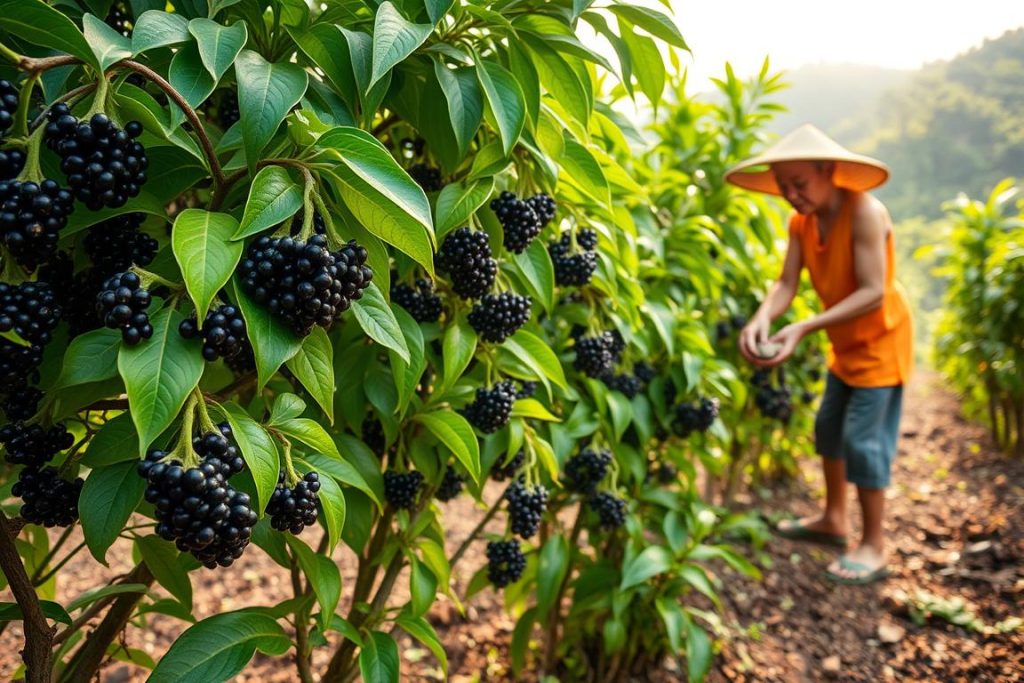
The hard work in getting peppercorns makes the best ones special. Like Tellicherry, known for its great taste and smell.
Global Production and Trade Today
Black pepper is the most traded spice worldwide. It’s grown in many places, not just Southeast Asia. Countries like Vietnam, Indonesia, Brazil, and Africa grow a lot of pepper now.
Major Producing Regions
India grows the most pepper and exports a lot. Vietnam is also a big player. Brazil, Indonesia, and African countries add to the global pepper trade.
Economic Impact and Market Trends
The black pepper industry is changing fast. People want better, sustainable pepper. The market is growing, with a value of USD 2,476.4 million in 2024.
This growth is because more people want to try new flavors. They also see pepper as healthy. The global middle class is getting bigger, too.
| Major Producing Countries | Export Value (in USD million) |
|---|---|
| India | 1,210 |
| Vietnam | 1,020 |
| China | 727 |
| Brazil | 322 |
| Spain | 283 |
The spice trade, led by black pepper, is key to the world economy. As the market changes, everyone must adapt. They need to focus on sustainable, high-quality pepper cultivation for the spice market and global trade.
Culinary Applications and Uses
Black pepper is very important in cooking. It has a strong smell and taste. It makes many dishes taste better.
There are different ways to use black pepper. Whole peppercorns are great for soups and stews. Cracked pepper is good for grilled meats and veggies. Fine pepper is best for sauces and dips.
Black pepper also balances rich foods. It makes creamy sauces and fatty meats taste better. It makes flavors work well together.
In today’s cooking world, black pepper is still the king of spices. Chefs and home cooks love it. They use it in many ways, from old recipes to new ones.
| Pepper Grind Size | Culinary Applications |
|---|---|
| Whole Peppercorns | Infusing broths, simmering stews, pickling |
| Cracked Pepper | Seasoning grilled or roasted meats, vegetables |
| Coarse Ground | Spice rubs, marinades, hearty dishes |
| Medium Ground | Seasoning sauces, dips, dressings |
| Fine Ground | Seasoning at the table, finishing touches |
Black pepper is not just for cooking. It’s also in many spice blends. Cooking with black pepper makes any dish better. It’s a key part of spice blends for culinary creations.
Health Benefits and Medicinal Properties
Black pepper is more than just a spice. It makes our food taste better and is good for our health. Its main part, piperine, is a strong antioxidant. It fights off bad stuff and lowers the chance of long-term diseases.
Digestive Health Benefits
Black pepper is great for our stomach. Piperine helps make more acid in our stomach. This is key for breaking down food and getting nutrients.
It also helps with gas in our intestines. This makes our gut feel better.
Antioxidant Properties
Piperine is a strong antioxidant. Studies show it fights off free radicals and lowers disease risk. In one study, rats eating black pepper had less damage in their cells than those without it.
Piperine also fights inflammation. This is good for many health issues. It might even help with Alzheimer’s and Parkinson’s.
Black pepper also helps our body absorb important nutrients. It can help control blood sugar and cholesterol. Some studies say it might stop cancer cells from growing.
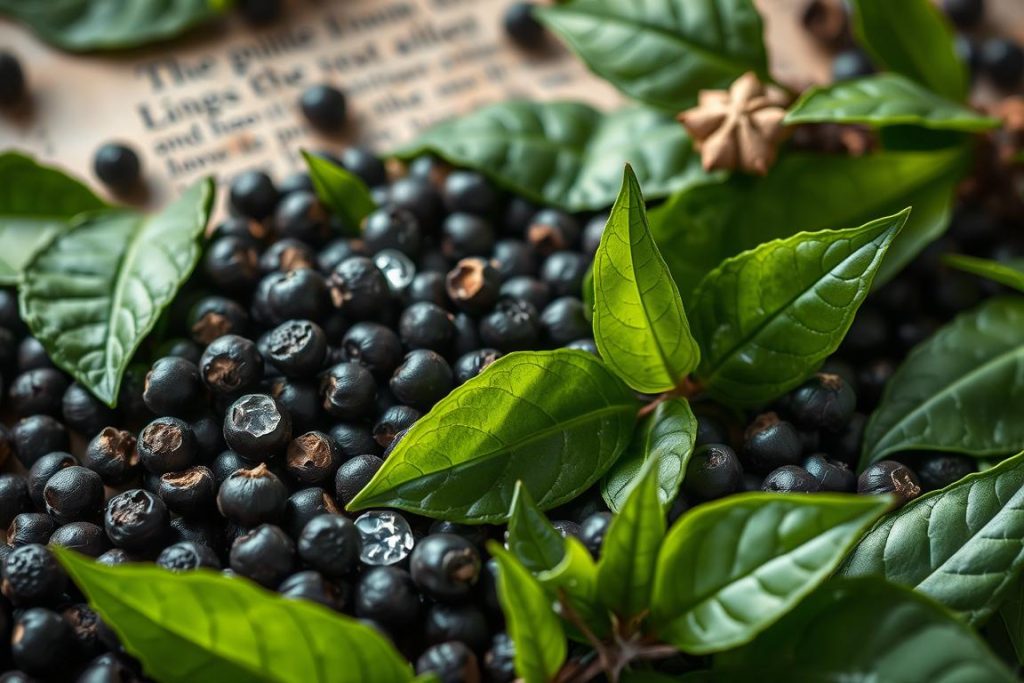
“Black pepper is a true powerhouse of health benefits, thanks to its remarkable antioxidant and digestive-supporting properties.”
More research is needed to know all about black pepper’s health benefits. But, what we know so far is promising. Adding black pepper to our meals can make us healthier.
Storage and Preservation Techniques
Keeping black pepper fresh is very important. It helps keep the spice’s quality, taste, and smell good. Here are some tips to keep black pepper fresh for a long time.
Optimal Storage Conditions
Store black pepper in a sealed container. Keep it away from sunlight, heat, and moisture. Glass or ceramic containers are best because they don’t harm the spice.
Place the container in a cool, dry spot. A pantry or spice cabinet is perfect.
Shelf Life Considerations
- Ground black pepper stays fresh for 6 months to a year.
- Whole peppercorns can last 3-4 years if stored right.
- Use black pepper powder within 6 months for the best taste.
Maintaining Moisture Content
Black pepper should have about 13% moisture. This keeps its strong flavor. White pepper should have less than 13.5% moisture.
Use desiccants like silica gel packs to keep moisture out. This helps keep the pepper fresh.
| Pepper Type | Recommended Moisture Content |
|---|---|
| Black Pepper | Around 13% |
| White Pepper | No more than 13.5% |
Check stored pepper often for moisture or mold. This keeps it fresh and tasty. With the right storage, you can enjoy black pepper’s unique flavors for a long time.
“Proper storage is the key to preserving the potent aroma and flavor of black pepper.”
Black Pepper Grades and Quality Standards
Black pepper is graded carefully in the spice trade. This ensures quality and authenticity. Knowing these standards is key for both makers and buyers.
Commercial Classifications
Peppers are sorted into three grades: Grade I, Grade II, and Grade III. These grades look at size, shape, color, and taste.
Grade I black pepper must be dense. Grade III is less dense. Ground pepper’s moisture is also checked.
Quality Indicators
Pepper is checked for many things. This includes ash content and aflatoxin levels. These are important for safety.
Pepper’s oil and piperine levels are also checked. So is the amount of unwanted stuff. Rules for safety are strict.
| Quality Indicator | Grade I | Grade II | Grade III |
|---|---|---|---|
| Bulk Density (g/l) | ≥550.0 | 500.0 – 550.0 | ≥450.0 |
| Moisture Content (%) | ≤12.0 | 12.0 – 13.0 | ≤13.0 |
| Total Ash (%) | ≤6.0 | 6.0 – 7.0 | ≤7.0 |
| Aflatoxin Total (µg/kg) | ≤20 | ≤20 | ≤20 |
These strict standards keep black pepper quality high. They follow food safety rules too.
Traditional Medicine and Ayurvedic Uses
Black pepper has been used for centuries in traditional medicine, especially in Ayurveda. It’s a versatile spice used in many remedies. It’s often mixed with honey or other natural ingredients to help with health issues.
In Ayurveda, black pepper is prized for its digestive and medicinal benefits. It’s used to soothe sore throats, clear nasal congestion, and treat colds and coughs. The compound piperine in black pepper helps other beneficial compounds work better.
Research shows black pepper has many health benefits. It can reduce inflammation, pain, and improve memory. It also helps lower cholesterol and fight off infections.
Black pepper has a long history in traditional medicine and is backed by science. As more people seek natural health options, black pepper’s role in medicine is growing.
| Traditional Uses of Black Pepper in Ayurveda | Emerging Scientific Evidence |
|---|---|
|
|
Black pepper’s ancient and modern uses show its lasting value in medicine. It’s a natural remedy with great potential in today’s healthcare.
“Black pepper has been a cornerstone of traditional Ayurvedic practices for centuries, and the growing body of scientific research is only beginning to uncover the full extent of its therapeutic potential.”
Modern Research and Scientific Studies
Scientists have been studying black pepper’s health benefits a lot. They look at how it helps with digestion and brain function. This spice is very interesting to them.
They are looking at how black pepper helps with brain diseases. These diseases, like Alzheimer’s, affect many people. The spice’s active part, piperine, might help protect the brain from damage.
Black pepper might also help with inflammation. This could protect our tissues. It also has antibacterial effects, which could help fight infections.
Research shows piperine can stop cancer cells from growing. It might also help us absorb nutrients better. This is good for our gut health.
But, we should not eat too much black pepper. It can upset our stomach. Also, be careful with piperine supplements because they can interact with medicines.
Even with these warnings, black pepper is very promising. It could help us stay healthy and fight off diseases.
Sustainable Farming Practices
The demand for black pepper is rising. The industry is now focusing on sustainable farming. This helps the environment and keeps pepper farming going for a long time.
By using eco-friendly methods, we can protect the land. We also save natural resources. This makes the spice industry more sustainable for the future.
Environmental Considerations
Managing black pepper waste is important in sustainable farming. This waste, called “spent,” can be used in many ways. It can be composted to make the soil better.
It can also be added to animal food or used as fuel. These actions reduce waste and make the production process better.
Future of Pepper Cultivation
The spice industry is looking at new ways to farm pepper. In places like Vietnam, over 50% of the pepper market is found. They are working on using less chemicals and helping women farmers.
They are training women and working with local suppliers. The aim is to help women and improve their role in the industry.
